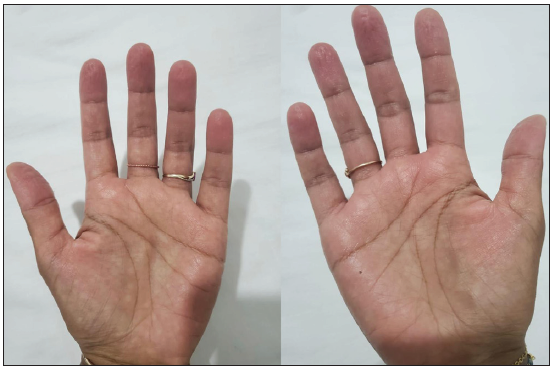Translate this page into:
Hunan hand syndrome managed in the intensive care unit
Corresponding author: Dr. Adrien Perrier, Department of Dermatology, University Hospital of Martinique, Pierre Zobda Quitman Hospital, Fort-de-France, Martinique. adrien.perrier19@hotmail.fr
-
Received: ,
Accepted: ,
How to cite this article: Perrier A, Amazan E, Habibourahimane T, Olivier N. Hunan hand syndrome managed in the intensive care unit. Indian J Dermatol Venereol Leprol. doi: 10.25259/IJDVL_427_2024
Dear Editor,
Hunan hand syndrome is a burning sensation in the hands after prolonged unprotected handling of chilli peppers.1 Chilli peppers are commonly used in Mexican, Asian, South American and Creole cuisine. We report a case of Hunan hand syndrome in Martinique (French West Indies) requiring analgesic treatment in an intensive care unit.
A 31-year-old woman with no history of allergy or known drug addiction was handling chilli peppers when cooking. She thought she was handling Capsicum Chinense called ‘vegetarian’ or ‘sweet’ chillies, whereas she was handling Capsicum Chinense called ‘habanejo’ chillies or ‘bondamanjak’ in the West Indies. Handling lasted for about an hour without gloves.
A sensation of heat and severe pain appeared gradually in the hands. Immersion in ice-cold water, milk or flour did not relieve the symptoms and even worsened the pain. The patient then went to the hospital because of the pain.
She presented with tachycardia, mild oedema and discrete erythema of the palmar side of both hands [Figure 1], contrasting with a pain visual analogue scale (VAS) of 10/10 and severe allodynia.

- Mild erythema and edema on both hands.
Oral Paracetamol (1 g), oral ketoprofen (100 mg), oral nefopam (20 mg) and topical therapy with silver sulfadiazine were ineffective in the hour after her arrival at the emergency room.
The patient was transferred to the intensive care unit where morphine titration with 15 mg IV was performed but was not sufficient. A 50 mg IV ketamine and a 10 mg morphine syringe pump were required for sedation and pain control. The patient was sedated for about five hours and she left the hospital the day after the episode.
The patient was seen in a dermatology consultation three weeks later. There was residual neuropathic pain on the palmar side and fingertips. Pregabalin 25 mg twice daily orally was introduced with good improvement in the residual neuropathic pain. Two months after the episode, mild pain persisted in the fingertips. The patient described a recrudescence of symptoms at the sight or when thinking of chilli peppers, suggestive of post-traumatic stress disorder.
Hunan hand syndrome was first described in 1981 by R.B. Weinberg, and corresponds to a burning sensation in the hands after handling Capsicum Japonicum.1 The molecule responsible for the burning sensation is capsaicin (8-methyl-N-vanillyl-6-nonenamide), a member of the alkaloid family and an active component of chilli peppers. Capsaicin is thought to cause depolarisation of unmyelinated C and Aδ thinly myelinated fibres via TRPV1 (transient receptor potential vanilloid-1). TRPV1 is responsible for the nerve signal for pain and burning.2,3 Few other cases are described in the literature, and no codified management has been established. Some patients have shown a reduction in pain with lidocaine gel, topical corticosteroids, oral gabapentin, topical sodium bicarbonate and cold water.1,2,4 Saxena et al. report the efficacy of bilateral stellate nerve block with a pump delivering 2 mL per hour of bupivacaine 0.125% and 2 mg of butorphanol for five days.4
Gabapentin can also be used, preventing the re-entry of calcium into the neuron and thus preventing the release of substance P responsible for pain, with a presumably longer onset of action.4
As capsaicin is fat-soluble, some patients apply milk or vinegar to the exposed area at home. One study compared the use of cold water or oil immersion on a group of volunteers exposed to hot pepper. Cold water relieved pain faster but not completely, while oil reduced pain completely, but with a slower onset of action.5
In our case, none of the topical treatments brought her relief, and some were counterproductive, worsening the pain. Only sedation with ketamine and morphine were useful.
Our patient also described a persistence of pain a few weeks after the initial episode, partially relieved by pregabalin.
Interestingly, our patient describes a condition with similarities to post-traumatic stress disorder.
The Hunan hand syndrome can be prevented by wearing gloves when handling chillies. Contact with mucous membranes or other parts of the body should also be avoided.
Declaration of patient consent
The authors certify that they have obtained all appropriate patient consent.
Financial support and sponsorship
Nil.
Conflicts of interest
There are no conflicts of interest.
Use of artificial intelligence (AI)-assisted technology for manuscript preparation
The authors confirm that there was no use of AI-assisted technology for assisting in the writing or editing of the manuscript and no images were manipulated using AI.
References
- Contact dermatitis associated with capsaicin: Hunan hand syndrome. Ann Emerg Med. 1995;25:713-5.
- [CrossRef] [PubMed] [Google Scholar]
- Capsaicin (TRPV1 Agonist) therapy for pain relief: Farewell or revival? Clin J Pain. 2008;24:142-54.
- [CrossRef] [PubMed] [Google Scholar]
- Multimodal approach for the management of Hunan hand syndrome: A case report. Pain Pract. 2013;13:227-30.
- [CrossRef] [PubMed] [Google Scholar]
- Household treatment for “chile burns” of the hands. J Toxicol Clin Toxicol. 1987;25:483-91.
- [CrossRef] [PubMed] [Google Scholar]





